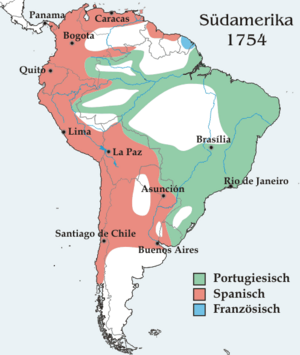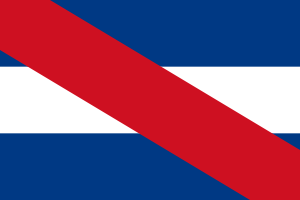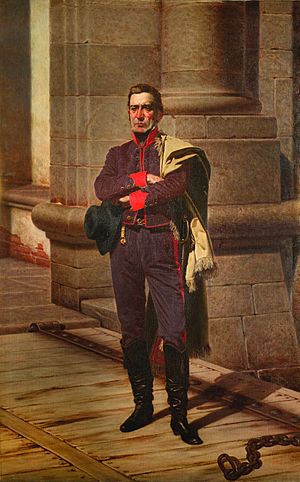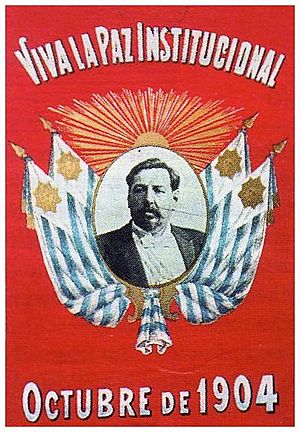History of Uruguay facts for kids
The history of Uruguay tells the story of this South American country. It covers four main times: the early history before the 1500s, the colonial period when Europeans arrived, the time when Uruguay became a nation, and its journey as an independent country until today.
Contents
Early History of Uruguay
Long before Europeans arrived, people called hunter-gatherers lived in the area that is now Uruguay. They found their food by hunting animals and gathering plants. Around the 1500s, there were about 9,000 Charrúa people and 6,000 Chaná and Guarani people living there.
Scientists have found old tools like Bolas, which are about 7,000 years old. These were used for hunting. Ancient rock art has also been discovered at a place called Chamangá.
European Arrival and Control

The Spanish first arrived in 1516. They were looking for gold and silver. They named the area Banda Oriental, which means "east bank of the River Uruguay".
The first explorer to land was Juan Díaz de Solís, but local native people killed him. Other famous explorers like Ferdinand Magellan and Sebastian Cabot also explored the area. However, they did not stay because they did not find any gold or silver.
Bringing Animals and Settling Down
In 1603, a leader named Hernando Arias de Saavedra brought cattle and horses to the area. These animals helped the land become more useful.
The first lasting European settlement was started by Spanish Jesuit priests in 1624. They built a mission at Villa Soriano on the Río Negro. They hoped to create a system for the Charrúa people.
Fighting for Control
In 1680, the Portuguese built a town called Banda Oriental on the northern bank of the Rio de la Plata (River Plate). Spain then attacked the Portuguese and built their own city, Montevideo.
By the late 1700s, the Spanish had pushed the Portuguese out of Uruguay. They set up a Spanish colonial city hall called a cabildo. They also divided the land among local cattle ranchers. By 1800, over 10,000 people lived in Montevideo. Another 20,000 lived in the rest of the province. About 30 percent of these people were African slaves.
The British, Spanish, Portuguese, and local people all wanted to control the area around the Río de la Plata Basin. Fighting started in the early 1800s. The British seemed to be winning. However, they then became allies against Napoleon in Europe, and their focus changed.
Becoming an Independent Nation
Artigas Leads the Way
Jose Gervasio Artigas led the people of Uruguay in a war against Spanish rule. The city of Buenos Aires tried to help. But they stopped helping when the Spanish leader threatened to send Portuguese troops to take over Banda Oriental.
Spain was allowed to keep control of Montevideo until 1813. Then, Artigas joined another army from Buenos Aires and took the city. The people declared Artigas the Protector of the League of the Free People. He also divided land among small farmers.
In 1816, forces from Brazil invaded and took control of Montevideo. Banda Oriental then became part of Brazil.
Uruguay Becomes a Buffer State
After more fighting, Brazil and Argentina signed the Treaty of Montevideo. They agreed to recognize Uruguay as a buffer state between them. A buffer state is a country or region placed between two hostile nations to help prevent them from fighting.
The Constitution of 1830 was approved in September 1829. It was officially adopted on July 18, 1830.
The Two Main Political Parties
Soon after Uruguay became independent, two main political parties formed. They began a civil war. The Blancos ("Whites") were the conservative party. The Colorados ("Reds") were the liberal party. They got their names from the colors of the armbands their supporters wore.
Wars continued to trouble the country. The Colorados eventually took power and ruled without stopping from 1865 until 1958.
The Batlle Era (1903–1933)
José Batlle y Ordóñez was President from 1903 to 1907 and again from 1911 to 1915. The Blancos tried to revolt one last time in 1904, but they did not succeed.
Under President Batlle, the government made many important changes. These included new political, social, and economic programs. For example, they started a welfare program to help people. The government also became more involved in the economy.
Some key changes during this time were:
- Income tax for lower incomes was removed in 1905.
- Secondary schools were built in every city by 1906.
- Women were given the right to divorce in 1907.
- The telephone network became owned and run by the government (nationalized) in 1915.
Uruguay in the 20th Century
Uruguay faced difficulties during the Great Depression. However, its economy did well during World War II and the Korean War. The country supplied beef, wool, and leather to European countries and the United States.
Military Rule (1973–1985)
After these wars, Uruguay's economy struggled again. A military dictatorship took power. The military made sure the dictator stayed in charge. People who opposed the government faced harsh treatment. This military rule lasted until 1985.
Recent History
Large protests against the dictatorship happened in 1984. The military was then forced to let civilians rule the country again. National elections were held later in 1984.
The leader of the Colorado Party, Julio María Sanguinetti, won the presidency. As president, he changed how the country was run, and the economy improved.
Presidential elections have continued regularly since then. Uruguay has seen more economic growth and new job opportunities for its people.
Interesting Facts About Uruguay's History
- Uruguay was named after the Uruguay River. The name means "river of the painted birds."
- The "Sun of May" is an important symbol. It first appeared during a public gathering on May 25, 1810, in Buenos Aires. It was seen as a good sign during the fight for independence from Spain. It is now on the top left corner of the flag of Uruguay.
- Suriname is the only country in South America that is smaller than Uruguay.
- In Uruguay, cows outnumber people four to one. There are about 12 million cattle but only three million people.
- Uruguayans eat the most beef per person in the world.
- Uruguay has the longest national anthem. It is more than 5 minutes long when performed.
- The Uruguayans have won the soccer World Cup twice. They were the first hosts and winners of the tournament in 1930. They won it again in 1950.
- In 2009, Uruguay became the first country in the world to give every student a free laptop and wifi access.
- The people of Uruguay love to drink mate. It is a tea made from the leaves of the yerba mate plant and boiling water.
- Over half of the country’s 3.3 million people live in the capital city, Montevideo.
See also
 In Spanish: Historia de Uruguay para niños
In Spanish: Historia de Uruguay para niños
- History of the Americas
- History of Argentina
- History of Brazil
- History of Latin America
- History of South America
- List of presidents of Uruguay
- Politics of Uruguay
- Portuguese colonization of the Americas
- Spanish colonization of the Americas
Images for kids











